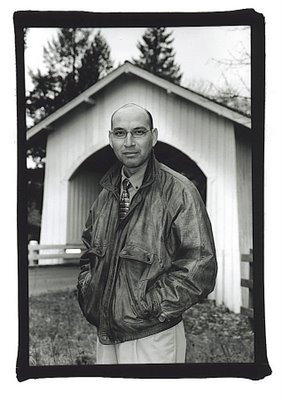Do You See What I See?
But photography is not all seeing in the sense that the eyes see. Our vision, a binocular one, is in a continuous state of flux, while the camera captures and fixes forever (unless the damn prints fade!) a single, isolated condition of the moment. Besides, we use lenses of various focal lengths to purposely exaggerate actual seeing . . .
- Edward Weston
 Previsualization is the art of pure seeing. Just like a painter staring at a blank canvas, a photographer formulates an image in the mind first and then relies upon the lenses to bring that vision to fruition. Not all of these ideas will pan out however, but I still insist in all my classes that the students learn to form a mental picture (approximately, of course) of every focal length before they even begin to peer through the lens to snap their photograph.
Previsualization is the art of pure seeing. Just like a painter staring at a blank canvas, a photographer formulates an image in the mind first and then relies upon the lenses to bring that vision to fruition. Not all of these ideas will pan out however, but I still insist in all my classes that the students learn to form a mental picture (approximately, of course) of every focal length before they even begin to peer through the lens to snap their photograph.
 Back in the old days with film and single focal length lenses, previsualization was imperative because knowing what a wide, normal, or telephoto lens would cover and create saved effort, energy, and time. It's easy to imagine how many moments might be missed fumbling through a camera bag or while locking and unlocking an improper lens choice.
Back in the old days with film and single focal length lenses, previsualization was imperative because knowing what a wide, normal, or telephoto lens would cover and create saved effort, energy, and time. It's easy to imagine how many moments might be missed fumbling through a camera bag or while locking and unlocking an improper lens choice.
But with digital technology and the proliferation of zoom lens availability and use, I'm often asked about the application and relevance of previsualization today. Sure, zoom lenses afford multiple focal length previews at the turn of a barrel, but I still believe it's worthwhile to understand the characteristics, and hence the end results, when using a full range of varying focal length lenses.

Even a simple comparison/contrast of wide, normal, and telephoto lenses shows the divergent effects they produce:
- Edward Weston
 Previsualization is the art of pure seeing. Just like a painter staring at a blank canvas, a photographer formulates an image in the mind first and then relies upon the lenses to bring that vision to fruition. Not all of these ideas will pan out however, but I still insist in all my classes that the students learn to form a mental picture (approximately, of course) of every focal length before they even begin to peer through the lens to snap their photograph.
Previsualization is the art of pure seeing. Just like a painter staring at a blank canvas, a photographer formulates an image in the mind first and then relies upon the lenses to bring that vision to fruition. Not all of these ideas will pan out however, but I still insist in all my classes that the students learn to form a mental picture (approximately, of course) of every focal length before they even begin to peer through the lens to snap their photograph. Back in the old days with film and single focal length lenses, previsualization was imperative because knowing what a wide, normal, or telephoto lens would cover and create saved effort, energy, and time. It's easy to imagine how many moments might be missed fumbling through a camera bag or while locking and unlocking an improper lens choice.
Back in the old days with film and single focal length lenses, previsualization was imperative because knowing what a wide, normal, or telephoto lens would cover and create saved effort, energy, and time. It's easy to imagine how many moments might be missed fumbling through a camera bag or while locking and unlocking an improper lens choice.But with digital technology and the proliferation of zoom lens availability and use, I'm often asked about the application and relevance of previsualization today. Sure, zoom lenses afford multiple focal length previews at the turn of a barrel, but I still believe it's worthwhile to understand the characteristics, and hence the end results, when using a full range of varying focal length lenses.

Even a simple comparison/contrast of wide, normal, and telephoto lenses shows the divergent effects they produce:
- Wide Angle - Foreground expands, background diminishes; depth of field increases dramatically and inherently; subject size reduces and lines converge.
- Normal - Foreground/background neutral, normally parallel to the horizon; depth of field mainly determined by aperture setting; subject size neutral and lines are typically perpendicular and parallel.
- Telephoto - Foreground contracts, background compresses and objects enlarge; depth of field decreases dramatically, even stopped down; subject size expands and lines remain perpendicular and parallel.
A camera doesn't function like the human eye and lenses offer a distorted view of reality. But through practice and a mastery of previsualization, soon you'll "see" your image before you even trip the shutter and what you see will be what you wanted.


0 Comments:
Post a Comment
<< Home